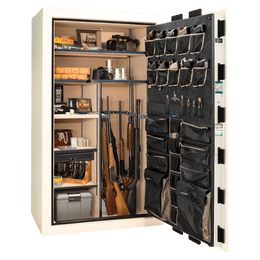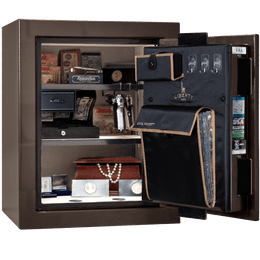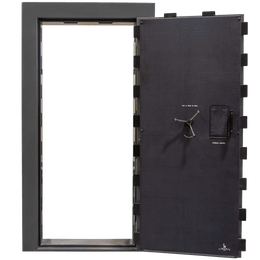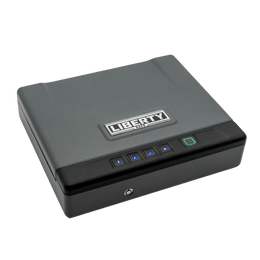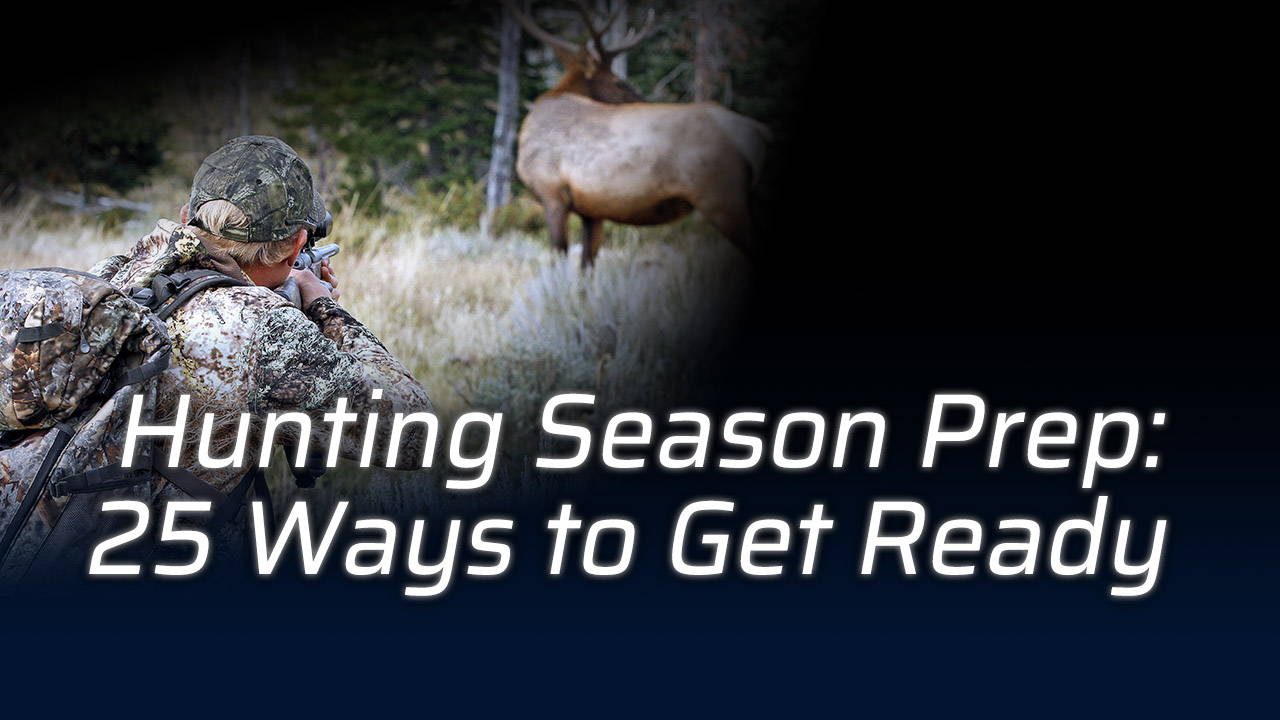With the huge influx of new hunters over the past few years, it’s important to share information that newer hunters may not know to keep everyone safe and ensure a good experience. For one person, the term hunting may mean a leisurely drive (or walk) out to a tree stand or blind for a relaxing morning in nature’s beautiful surroundings. For another, it can be an extreme mountaineering slog up rocky, icy, high-elevation peaks. Whatever your preference or quarry you’re after, let’s go over some of the key steps every hunter needs to focus on to be better prepared for hunting season.
Getting your firearm or bow ready to hunt
Since prehistoric hunters used clubs, throwing sticks, axes, bows, slings, atlatls, darts, or other weapons, preparing this technology has been an essential part of the hunt. Today, the primary hunting weapons are either a bow/crossbow or some type of firearm, whether a muzzleloader, rifle, shotgun or a handgun like a revolver. While most people today don’t make their hunting weapons themselves, it’s still important to prepare these tools for hunting season to help ensure safety and success. Let’s review some of the primary steps a responsible hunter will undergo before each season.
Preparing your firearm or bow for the hunt
Some people use their firearms or bow once a year for a single hunt and put them away, while others use them regularly for seasonal hunting and recreation. Regardless, you should thoroughly inspect your hunting weapon before each season and perform any needed maintenance to ensure it’s in top working order.
Firearms should be cleaned, lightly lubricated, and thoroughly checked for proper function. Examine each part of the gun. Look at the sights, scope, or optic for signs of damage or corrosion. Replace any batteries. Check the common firearm wear areas like bolt locking surfaces, bolt faces, firing pin holes, firing pins/strikers, slide rails, and safety buttons/levers to ensure they’re in good shape and debris-free. Verify any safety mechanisms are functioning correctly. Pay close attention to any sling swivels or bipod/tripod mounts to make sure they’re not working loose. Check shotgun chokes to ensure they’re not coming loose (or worse, rusted in place). Lube them with choke lube or a suitable anti-seize compound. Confirm that your shotgun forend/barrel nut/magazine cap is tight and that there’s no movement in the forend or barrel.
Bow/crossbow limbs, pulleys, and strings should be carefully inspected, and any frayed or nicked parts should be replaced by a knowledgeable person with the proper tools. Look at your nocking points and release/trigger mechanisms (if using) to ensure they’re functioning safely. Sights should be visible, clear, and secured to the bow.
Preparing your hunting ammunition/projectiles
After you’ve cleaned and verified the safe/functional condition of your hunting implement of choice, it’s time to get your ammo or arrows/bolts ready. If you reload or handload, you should already have verified the safety, accuracy, and, ideally, the effectiveness of any bullet and powder combination. You probably won’t need a hundred rounds (unless you live on a Texas game preserve, you lucky dog), but at a minimum, prepare enough loaded ammo to get you through a season, accounting for zeroing (see below), potential misses, and any necessary situations where multiple shots may be required. If you purchase factory ammunition, it should be from a reputable maker, and you should buy enough of the same type and lot number to get you through the season. Confirm the condition of each round before heading into the wild. Sometimes, weird things happen with factory ammo, even from a premium maker. Primers can be flipped, crimps done improperly, bullets damaged, etc.
Bow or crossbow hunters should prepare a good supply of arrows/bolts and get their preferred hunting broadheads nice and sharp. They should also check all fletching, shafts, threaded inserts, and nocks for damage, wear, defects, or looseness.
Confirming your zero / sighting in
Changing too many variables right before a hunting season is not a good idea. A new rifle, new ammunition, different bullet/arrow/broadhead weight, different optics, etc. will dramatically impact accuracy, and that can mean the difference between an ethical kill, a wounded/lost animal, and a total miss. You absolutely must verify your zero with your selected hunting implements and ammunition before you shoot at an animal with them. To do otherwise is irresponsible and potentially dangerous to other hunters.
Suppose you are familiar with your bow/arrow or rifle/ammo setup and have shot it frequently enough to confidently hit your target at your selected maximum distance (and you should). In that case, you may only need two or three shots to confirm your zero. If everything looks good and you haven’t made any changes to your setup, you’re good to go. If you’ve changed optics, equipment, ammunition, bullet weight, powder charge/type, arrow brand/weight, or broadhead type/weight, you must re-zero your rig before you hunt with it. Head to the range and get your sights dialed in perfectly.
Preparing your gear for hunting season
Experienced hunters know there’s much more gear to worry about than just a rifle, shotgun, handgun, or bow. All that gear must be acquired, and its condition must be checked well before opening day.
- Boots/socks: A good pair of waterproof hunting boots and socks can distinguish between a pleasant outing and a miserable experience. Get the good stuff, and your feet will thank you. If your boots are leather, condition them according to the manufacturer’s recommendations. Check for frayed laces, missing eyelets, separating soles, and other problems. Synthetic boots may also need to be treated with waterproofing spray. If your favorite socks are worn thin, spring for a fresh pair. Your feet will thank you. Pack a spare pair of socks in a waterproof pouch.
- Outerwear: This will vary greatly depending on where you live and what type of hunting you’re doing. Generally, you want quality, insulated, waterproof materials that can be layered for temperature regulation. Often, a camouflage pattern is preferred, but it is not always. You may be required by law to wear a certain amount of approved blaze orange outerwear when hunting in your state. Wear more than you think you need. It’s easy to visually lose a hunter in the brush, depending on lighting conditions and distance. Dress for the rain/cold even if you don’t think you’ll need it. It’s better to be hot and carry a waterproof outer layer than to be cold and wet and have no options.
- Pack: You may or may not hunt with a pack, but if you use one, get one that can comfortably hold all your necessities and won’t come apart 10 miles from the truck.
- Hydration: Make sure to carry enough water and pack an emergency filter and purification tablets. Synthetic hydration bladders with flexible drinking tubes and bite valves are becoming more common for hunting and convenient, especially if you’re wearing a pack. Even if you don’t need a pack, consider wearing a standalone hydration harness and be sure to drink more frequently than you may feel like you need. High elevations, sunny conditions, and dry air can suck the moisture out of you and you can quickly get dangerously dehydrated. Make proper hydration a priority during your hunt. You’ll perform better, think better, and stay alive better.
- Food: Depending on your hunting style, you might want this merely as a snack, or to keep your energy up during high-exertion hiking/hunting, or maybe this is part of your emergency kit (see below). But you should have some source of emergency calories at a minimum. Vacuum-packed pemmican, jerky, granola bars, and trail mix can taste like ambrosia after a long, strenuous hunt.
- Survival/emergency kit: This will vary greatly depending on how far you are from your transportation and what type of hunting you’re doing. However, any time you venture into the woods, fields, or desert, you should, at a minimum, carry a basic first-aid kit, an emergency blanket, and waterproof/windproof matches. Your survival rig can vary in complexity from there and, in some cases, might consume most of the space inside a pack. You’ll never regret carrying that survival gear if you ever need it. Ensure the matches are in good shape and haven’t crumbled to dust over the years.
- Binoculars, spotting scopes, rangefinders: Today, there are compact and lightweight combination binoculars/rangefinders. For mobile hunters, these can often replace a heavier, bulkier spotting scope. Check them over and replace the battery.
- Waders and decoys: Waterfowl hunters should check over their waders carefully for wear, fraying stitching, or holes. Confirm all buckles and safety belts are in place and functioning. Check your floating decoys for leaks/holes/damage, and confirm that any anchoring rigs are un-tangled and ready to deploy.
- Game calls: If you’re turkey, duck, goose, or swan hunting, you may be using calls. Be sure they’re in good working order, and bring a backup. Some turkey calls don’t work when they’re wet, for example. Mouth calls can grow mold (gross) or otherwise deteriorate. Make sure yours are ready to go.
- Blinds, tree stands: If you use portable hunting blinds, set them up in your yard or a field before opening day to ensure you know how to use them and that everything is in place and undamaged. Repair any tears or broken zippers. Tree stands should be inspected carefully, and any clamping mechanisms lubricated. Pay special attention to the safety harness and rescue climbing rig, especially if you are hunting alone.
- Emergency GPS/satellite rescue beacon: You might be fine with a quality cell phone in your hunting area. However, it’s a good idea to pay for a subscription to one of the various emergency satellite trackers/rescue beacons in the case of an actual emergency where you’re either lost or hurt and unable to move. With these devices, you can send out a signal that alerts searching parties and/or emergency medical personnel to your location. If you have a tracking beacon, install a fresh battery and confirm it’s functioning before opening day.
- Rifle or bow cases: If you stuffed your rifle or shotgun case behind the water heater at the end of last season and haven’t touched it since, it might be full of mildew, mold, bugs, or other critters. Check your firearm or bow case and ensure it’s clean and all fasteners function correctly.
- Hunting vehicle: Perform or schedule a tune-up and check all vehicles used for your hunting activities. Getting stuck in the boonies due to an improperly maintained vehicle isn’t just annoying… it can be life-threatening. Confirm the condition of your tires. Purchase a tire plug kit and a portable compressor to inflate the tire. Take maintenance seriously and address any issues well before the season begins. Take extra fuel and extra water, and stash an extra emergency kit somewhere in your rig.
- Field dressing kit/game bag and knife: If you’re going after medium or big game, be prepared to dress the animal and transport the carcass, whether with a drag harness, sled, or other suitable setup. If you need to dress the animal in the field, obtain a quality knife and sharpening stone/steel or make other arrangements for butchering. If you’re chasing ducks, geese, pheasants, or other small/upland game, carry the appropriate game pouch, straps, or loops to transport your harvested animals.
Physical, legal, and financial preparation for hunting season
In addition to your firearm/bow and necessary hunting gear, there are some other things you need to get in order before opening day. Let’s go over a few.
Get in shape (or make an effort to)
Much like Rule #1 of surviving Zombieland, the first rule of preparing for hunting season should be: Cardio. If you’ve sat at your desk munching cheezy poofs for the past year and intend to hike a 10,000-foot peak chasing your dream trophy mountain goat on opening day, we have some news for you: Hunting can be extremely strenuous. It might be the hardest thing you ever do. If you are going on a high-elevation hunt, do your best to acclimate yourself to the lower oxygen levels and steep hills by engaging in physical conditioning during the weeks and months preceding hunting season. If possible, spend time at altitude so your body can start to produce more red blood cells.
However, even if all you’re doing is driving your ATV to your tree stand, you still need to set it up, climb it, and drag your rifle/bow/gear up it, and all of this can take significant effort if you’re out of shape. Doing moderate strength conditioning can help build muscle and improve strength. Crossfit and/or cardio will build endurance and improve oxygen metabolism. If structured exercise isn’t your thing, at least go for regular long walks/hikes to prepare for the hunt. Carry your loaded pack often if you use it during the hunt. Note: Wear your hunting boots and break them in well, particularly if they’re new this season. Blisters suck.
Get time off from work and get caught up on projects
Depending on your job and how you prefer to hunt, you might need zero time off for your hunt, or you might need 3 weeks or more. Some people use up their entire year’s allotment of vacation days during hunting season. Make sure you plan in advance if you’re going to be out of the office. Get your projects completed, and notify your superiors/HR well in advance to ensure you can get all necessary time off. Depending on your work environment and the local political milieu, you may or may not want to mention that you’re going hunting. You may be better off just getting time off for vacation.
Obtain all necessary licenses, and ensure your equipment is legal
This may require serious advanced planning, as some big game tags can be nearly impossible to get. Once-in-a-lifetime draw permits will determine where and when you’ll be hunting, but luckily, you’ll likely know this months or even years before your hunt. Depending on where you live, you might need to apply for your state’s general deer hunt 9 or 10 months in advance. Special access permits can be even more tricky. Do your research and find out how and where you need to obtain all your permits well in advance. It seems silly that some hunters still show up to a hunting area in an unfamiliar state and expect to be able to buy a special-access deer tag at any local sporting goods counter, but it does happen. Plan ahead and get your tags and stamps early.
Additionally, now is the time to double-check the hunting regulations (whether in your own state or anywhere else you plan to hunt) to make sure your preferred configuration of firearm/ammo or bow/broadheads is still legal to use for your intended hunt. Each state has its own hunting regulations, and they can and do vary widely. They can also be updated annually and frequently change in small ways every few years. Don’t assume that since you hunted a certain state ten years ago that everything is still the same. Even professional guides may not be fully up to date on their own state’s regulations or restrictions. Read up on each relevant state’s wildlife/hunting resources website and get the accurate info from the horse’s mouth.
And if you haven’t taken a hunter safety course and learned how to safely hike with your rifle, shotgun, handgun, or bow, do so immediately.
Visit landowners and get advanced written permission if hunting private land
Don’t forget to get written permission to access any private land you wish to access during your hunt. You may be able to contact them via phone or email, but if possible, arrange to visit them personally so they can be further assured that you are a responsible, ethical hunter who will treat their land with respect. A little courtesy here can go a long way toward obtaining limited and possibly exclusive access to land that may be prohibited for other hunters.
Pro tip: If you get permission to hunt private land, be sure to pick up litter, close open gates (if instructed to do so), and note any issues with flooding, fallen trees, dead animals, signs of trespassing, trash dumping, fences in need of repair, etc. and provide a detailed report for the landowner after your hunt. He/she will greatly appreciate your information and this will further increase your chances of future access.
Scout your hunting location in advance and clear shooting lanes
This may not be possible if you’re traveling to Alaska or the Rockies for a special hunt, but if possible, scout your local hunting area in advance to learn the patterns of the animals. Good scouting can make the difference in a successful opening-day hunt and going home empty-handed as the season ends. If you’re stand hunting or prefer posting up at the base of a particular tree or bluff and watching for game, visit the location in the weeks leading up to your hunt and clear your shooting lanes/sight lines. You can use a chainsaw, or a hand/pole saw to clear limbs and brush (confirm this is allowed by your local regulations first). This is also a good time to use a rangefinder to mark out potential shot distances and work out any holdovers for bow or rifle shooting at those distances.
Set up game cameras and food plots (if legal in your area)
If you hunt your own land, you can prepare further: If legal and appropriate in your hunting area, set up game cameras to monitor game traffic and plant food plots to encourage game to visit.
Save up some dough in advance
The only thing worse than getting skunked on a big, expensive hunt is paying for it for years afterward. If you hunt in your local area, you might not need to make significant financial adjustments to cover the expenses relating to your hunting hobby. However, traveling for a special hunt can cost tens of thousands of dollars, depending on whether you’re buying special permits or hiring a guide. If you’re rolling in cash, fine… but most of us must prepare financially for the hit. Start budgeting and save your proverbial pennies in advance so you don’t have to struggle to pay off your credit card charges from THIS hunting season in time for the NEXT hunting season.
Tell someone where you’re going
Even if you’re hunting in a group, especially if venturing into the backcountry alone, tell someone where you’re going and how long you expect to be gone. Hunters get lost every year, and sometimes they don’t come back. Let a loved one know your plans, and update them if they change. This is not only for your safety but can alleviate any stresses or concerns on their end.
Store your hunting firearms and expensive gear in a Liberty Safe
So there you have it… 25 (or more) helpful tips for getting ready for hunting season. Remember to properly clean and maintain your firearm or bow after the season’s over, and store all your guns and valuables in a quality gun safe from Liberty. This can prevent theft and unauthorized access, and an adequately dehumidified safe can prevent costly environmental damage like rust, mold, and corrosion.
*Made in the U.S.A. from U.S. and Global Parts.


